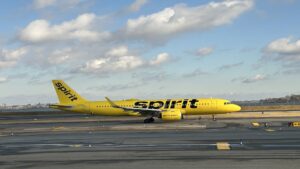Spirit Airlines Enters Chapter 11: A Closer Look at the Budget Airline’s Challenges and Future
In a stunning turn of events that has sent shockwaves through the airline industry, Spirit Airlines has filed for Chapter 11 bankruptcy protection. After establishing itself as a pioneer in the realm of budget travel, the airline faces a challenging economic landscape marked by rising costs, increased consumer expectations, and a failed merger with JetBlue Airways.
The Brave New World of Spirit Airlines
Spirit Airlines, the brainchild of the low-cost travel model that reshaped the skies for budget-conscious travelers, announced early Monday that it has entered a prearranged bankruptcy process. This decision does not immediately ground its planes; in fact, the airline assures customers that they can continue to book flights as usual during this transition. A critical aspect of this development is a $300 million debtor-in-possession financing agreement with bondholders, ensuring that vendors and aircraft lessors remain uncompromised during this process.
However, the road to this unfortunate decision has been anything but smooth. Spirit’s operational challenges have been mounting. A significant engine recall that left many jets grounded, coupled with soaring operational costs post-pandemic, has compounded the airline’s difficulties. Adding fuel to the fire, the failed merger with JetBlue, which was scuttled by a federal court citing antitrust concerns, has further destabilized Spirit’s financial landscape. The carrier’s stocks reflect a grim reality, plummeting over 90% in just a year.
Historical Context: A First in Over a Decade
With its bankruptcy filing, Spirit becomes the first major U.S. airline to seek Chapter 11 protection since American Airlines did so 13 years ago. This marks a significant moment in the airline industry, particularly in the aftermath of a global pandemic that has reshaped travel habits and airline profitability.
The Financial Strain of the Last Few Years
Since 2019, Spirit Airlines has not reported a profit. In the first half of this year alone, it suffered losses exceeding $335 million. To mitigate its financial strain, the airline has resorted to selling off assets, including 23 Airbus aircraft for $519 million. Such actions underscore the current aircraft scarcity in the market, providing a temporary relief valve for the struggling airline. They anticipate concluding the year with around $1 billion in liquidity, a semblance of hope amid the chaos.
The Shift in Business Model
Spirit’s business model, characterized by ultra-low fares and additional fees for services like seat assignments and carry-on bags, has drawn both avid supporters and sharp critics over the years. While this model successfully captured a lucrative market niche, the rise in consumer expectations post-pandemic has forced airlines, including Spirit, to rethink their strategies.
This past summer, Spirit took steps to appeal to a broader customer base by introducing bundled fare options that include seat assignments and other perks. They even ventured into "first-class" territory by offering larger seats, capitalizing on a growing trend where travelers are willing to pay more for additional comfort.
A Legal Battle Among Giants
Spirit’s tumultuous journey intensified earlier this year when a federal judge blocked JetBlue’s ambitious $3.8 billion acquisition of Spirit. Prior to this, Spirit had agreed to merge with Frontier Airlines, only to have JetBlue intervene with a higher cash bid, which ultimately fell through amid legal challenges. Judge William Young’s ruling highlighted the implications such a merger could have on competition and fare pricing in the primarily four-airline-controlled U.S. market.
In his judgment, Judge Young noted Spirit’s significance to a niche market. "Spirit is a small airline. But there are those who love it. To those dedicated customers of Spirit, this one’s for you," reinforcing the value of maintaining competition even in turbulent times.
The Road Ahead
As Spirit Airlines embarks on this restructuring process, industry experts anticipate that the carrier will need to undergo further downsizing to stabilize operations. They have already seen a reduction in workforce, with plans to furlough an additional 330 pilots in the coming months.
For avid travelers, the future of Spirit Airlines remains uncertain, yet the brand continues to symbolize the highs and lows of budget travel. As news continues to unfold, the Extreme Investor Network is committed to keeping you informed on the latest developments and potential impacts on the airline industry and beyond.
Stay tuned for updates as this story evolves, and for exclusive insights into the business world’s changing landscape. Whether you’re an investor or a traveler, your understanding of these shifts can empower your decisions in an unpredictable marketplace.

